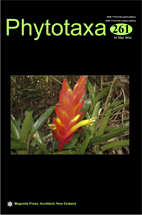Abstract
Several lines of evidence including morphology, chromosome numbers, karyotypes, and phenology were previously used to clarify the taxonomic relationship between Calligonum mongolicum and C. pumilum (Polygonaceae). We employed sequences of the commonly used bar-coding locus, the nuclear ribosomal ITS region, to differentiate Calligonum mongolicum and C. pumilum, based on a sampling scheme of seven populations in three desert regions in China. Phylogenetic analyses did not support the monophyly of each of the two species; instead, populations of the two taxa are intermixed in the analysis. This pattern of intermixing is consistent with the result of the neighbor-net analysis. The ITS region can distinguish other species beyond the C. mongolicum complex defined by morphology both within a section and among sections in Calligonum. The intermixed non-monophyletic pattern of the widespread C. mongolicum and the narrowly distributed C. pumilum supports the merge of C. pumilum with C. mongolicum, consistent with morphological, cytological and karyotype analyses. We herein formally treat C. pumilum as the synonym of C. mongolicum.

